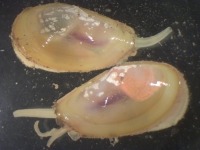
(Photo: Huntsman Marine Science Centre)
Short Yoldia Clam
Yoldia sapotilla
This bivalve is oval and elongated with a rounded anterior end and a narrow posterior end. The colour is pale green. It can grow up to 2.5 centimetres in length.
Authority
Gould, 1841
Classification Details
Phylum: Mollusca (molluscs); Class: Bivalvia (bivalve molluscs).
Habitat
Found on the east coast of North America, from Labrador to North Carolina. Occurs at depths of 0 to 82 metres. Prefers muddy substrates.
Diet
Sub-surface deposit feeder. Two long tentacles extend from pockets called labial palps on either side of the mouth. These search for organic particles in the sediment. Particles pass down a groove in the tentacle to the lamellae where ciliated tracts sort the particles.
Reproduction
Little information is available for this species. Bivalves have separate sexes or can be hermaphrodites. There is often a trochophore and veliger larval phase.
Fun Facts
This species is a major component of the diet of commercial fish species, including cod and haddock.
References
MolluscaBase (2020) MolluscaBase. Yoldia sapotilla (Gould, 1841). Accessed through: World Register of Marine Species at: http://www.marinespecies.org/aphia.php?p=taxdetails&id=157007 Accessed online 22 January 2020. Morris PA, Abbott RT and Peterson RT (2001) A Field Guide to Shells: Atlantic and Gulf Coasts and the West Indies. Boston: Houghton Mifflin Harcourt. Palomares MLD and Pauly D (2019) Sealife Base. Yoldia sapotilla (Gould, 1841) shot yoldia. https://www.sealifebase.se/summary/Yoldia-sapotilla.html Accessed online 22 January 2020.

